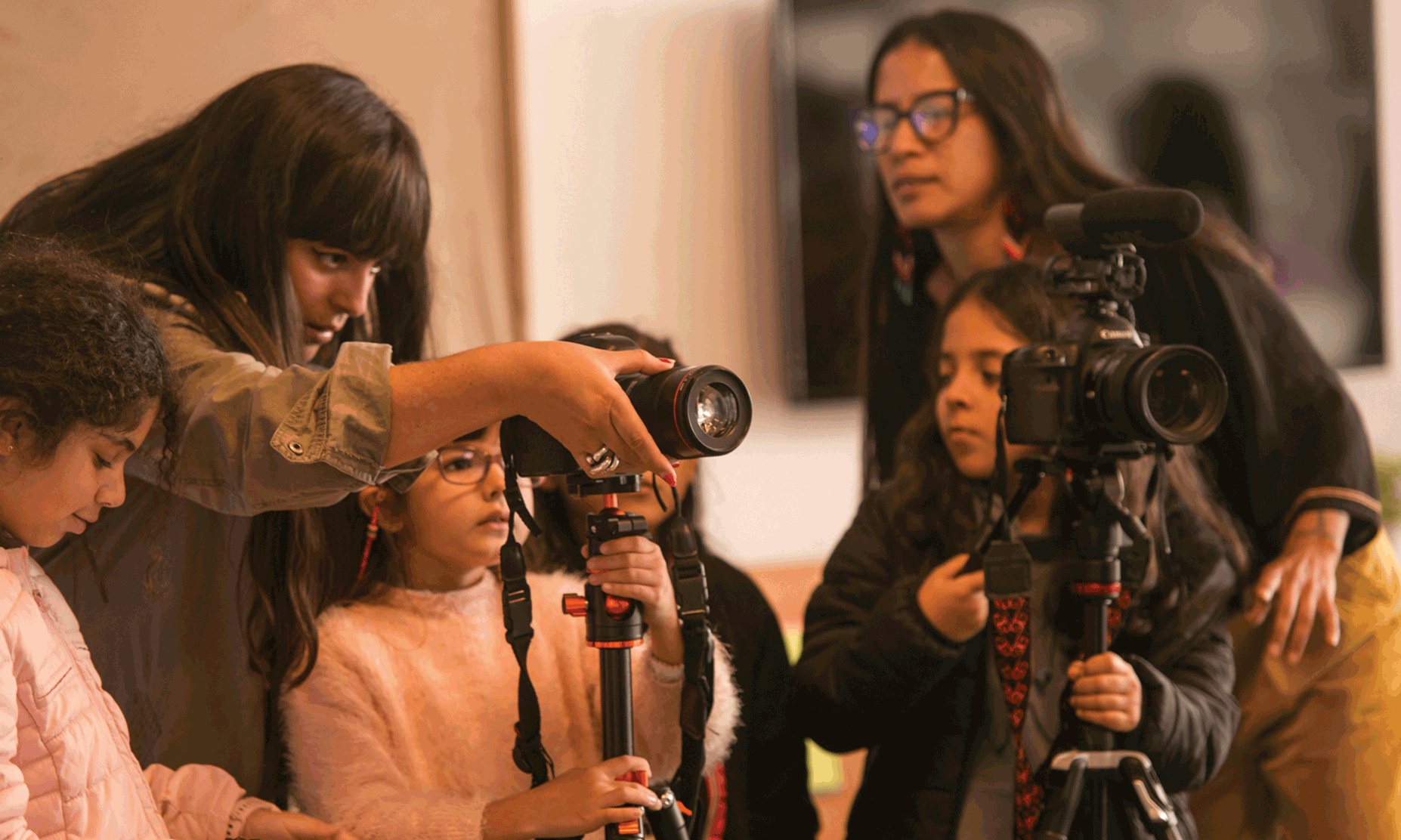Cristina Isabel Rivera Sangame (on left) and Diana Larrea (right) teach the next generation of film-makers at Lima’s Place of Memory, Tolerance and Social Inclusion
Photo: Denisse Ubillus; Courtesy of LUM
Peruvian film workers and artists are sounding the alarm about a bill passed by the country’s parliament that they fear will be used to censor their work and stifle freedom of expression. Approved in June by the right-wing majority in the legislature, the bill contains a section mandating that no state financing be distributed to projects that depict “political propaganda” or go against “the interests of the Peruvian state”.
The changes to the film funding legislation come at a time when the Peruvian film industry is flourishing, but democracy is on the ropes. Protests and violence have shaken the country since 2022, when vice president Dina Boluarte was put into power after the former president Pedro Castillo was impeached for attempting a coup.
Early in 2023, Peru’s constitutional court issued several rulings that were inconsistent with international human rights standards, including on same-sex marriage, Indigenous rights and justice for crimes against humanity. Protests have become increasingly frequent, with calls for Boluarte to resign or for a constituent assembly to review the constitution. Protesters are being met with increased police violence and repression, including reports of excessive use of force and mass detentions.
“For months now, Peruvian films about LGBTQ+ rights, identity, dissidence and especially productions about past political conflicts have been attacked by conservatives and historical negationists,” members of the group En Defensa del Cine Peruano (Defending Peruvian Cinema) wrote in a public letter in May that was signed by 70 unions and around 700 independent artists. None of them was consulted about the new law.
“Film is a way for us to talk about our diversity, and people have responded well to these stories,” Sonaly Tuesta, a documentary film-maker and the former vice minister of cultural affairs, tells The Art Newspaper. Her first feature film, the documentary Misión Kipi (2024), follows a public school teacher who creates a robot to hike with him through the Andes at the height of the Covid-19 pandemic, to reach his Indigenous students. Instead of supporting a growing industry that now includes more female directors and portrays women’s rights and Indigenous stories, Tuesta says, the bill “is a backward step, leaving us uncertain about how these state funds, which we worked hard for years to attain, will be managed in the future”.
The bill could also allow historical negationists to censor films that include unflattering or critical accounts of Peru’s decades of internal conflict, from 1980 to 2000, when nearly 70,000 people were killed. “We still don’t know how all of this will play out, but we are very worried,” Tuesta says.
The Place of Memory, Tolerance and Social Inclusion (Lugar de la Memoria, Tolerancia e Inclusión Social, LUM) in Lima is a public museum that preserves documents, archives and stories about the human rights abuses committed during the country’s internal conflict. In 2023 the far-right mayor of Lima, Rafael López Aliaga, tried to close the museum, claiming it peddled a “false narrative”. In June, the US-based Peruvian artists and film-makers Diana Larrea and Cristina Isabel Rivera Sangama returned to their homeland to teach a youth film workshop at LUM.
“Returning full circle to teach and showcase my independent film here felt very emotional,” says Larrea, who was born in 1983, early in the internal conflict, and migrated to the US in 2000, just as it ended. In the 24 years since her departure, the industry has grown enormously, with new productions made in Indigenous languages and stories about trauma and immigration. “It’s exciting,” Larrea says, “but now the government wants to silence these voices.”
“Sharing stories is a way for us to resist being forgotten,” says Rivera, whose mother was orphaned in a small village in the Peruvian Amazon and migrated to the US by herself to escape the violence of the internal conflict. She “left very painful things behind”, Rivera says. “It took me years of doing documentary work to get her to open up about her past.”
During the workshop at LUM, Larrea and Rivera brainstormed with each student something they wanted to remember or preserve. The goal was to create a one-minute group short. The children came from different regions; most had never seen a camera before. On a large notepad, the artists wrote two prompts for the students: “How can we tell the stories that represent us? How do you envision freedom in the film world?” It was June, and the new film legislation had just passed that week.
Peruvian film-maker Sonaly Tuesta says the new legislation is a “backward step”
Photo: Denisse Ubillus; Courtesy of LUM
The first night Larrea and Rivera met in Lima to plan their workshop, they encountered a protest in front of the Ministry of Culture. People working in the film industry held signs that read “No censorship, no dictatorship” and “Cinema is diversity and memory”. A few weeks later, during the opening of the 28th edition of Lima’s film festival, audiences booed as the culture minister Leslie Urteaga spoke. “The people are tired and don’t want to take it anymore,” Larrea says.
For Rivera, teaching children about the importance of self-expression has reinforced the importance of her own voice. In addition to her work in Peru, since last October she has worked with Palestinian artists in documenting the injustices and suffering that civilians are experiencing in Gaza. “If they kill us tomorrow, you can’t erase me completely because I told my own story,” she says.
Both artists plan to continue mentoring young film-makers. Rivera is headed to the Peruvian Amazon next to teach their workshop. “Maybe we won’t see certain changes in our lifetime,” she says, “but we can give these tools to younger people at least. It’s one of the most powerful things.”

